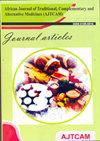PROSPECTS OF INTEGRATION OF NANOTECHNOLOGY TO ANTIMALARIAL HERBAL REMEDIES FOR IMPROVED THERAPEUTIC EFFICACY – A CONCISE REVIEW
African Journal of Traditional, Complementary and Alternative Medicines
Pub Date : 2022-12-22
DOI:10.21010/ajtcamv18i1.3
引用次数: 0
Abstract
Background: The therapeutic utility of herbal medicinal products including antimalarial herbal remedies has been hampered by some unfavorable biopharmaceutical properties of the bioactive constituents such as low aqueous solubility, poor oral bioavailability, poor intestinal permeability and large molecular size. Al these biopharmaceutical issues are responsible for observed reduced in vivo efficacy of some herbal products compared to their in vitro efficacy. These drawbacks can by countered by the integration of nanotechnology. The present article identified the various documented nanosystems and examined the recent efforts in the deployment of nanotechnology in formulations of antimalarial herbal medicines for improved therapeutic efficacies. Also safety considerations in clinical applications of nanoformulations were highlighted. Methods: The information was acquired from an extensive literature searching of electronic databases such as Science-Direct, PubMed, and Google-Scholar to obtain appropriate articles made in the English language which were published up to 2022, using a combination of relevant keywords. Results: Only very few herbal antimalarial remedies such as extracts of Azadirachta indica, Momordica charantia, Curcuma longa, and Artemisia species have been nanoformulated and evaluated for antimalarial efficacy. In all these studies, the drug-loaded nanoformulations exhibited significantly higher in vitro and/or in vivo antimalarial efficacy. The different nanoformulations of antimalarial herbal remedies that have been reported include nanoparticles of lipid-based, cyclodextrin, chitosan/lecithin , liposomes, nanosuspension, nanoemulsions, and metal-based nanoparticles.. Conclusion: Different types of nanoformulations of herbal antimalarial drugs have been reportedly prepared by different techniques and these offer advantages of improved efficacies. Safety concerns present a hurdle to clinical applications将纳米技术与抗疟疾草药结合以提高治疗效果的前景——简要综述
背景:包括抗疟中药在内的草药产品的治疗效用一直受到生物活性成分的一些不利的生物制药特性的阻碍,如低水溶性、低口服生物利用度、低肠通透性和大分子尺寸。所有这些生物制药问题都是导致一些草药产品的体内功效低于其体外功效的原因。这些缺点可以通过纳米技术的整合来弥补。本文确定了各种记录的纳米系统,并检查了最近在抗疟疾草药配方中部署纳米技术以提高治疗效果的努力。同时强调了纳米制剂临床应用中的安全性问题。方法:结合相关关键词,对Science-Direct、PubMed、Google-Scholar等电子数据库进行广泛的文献检索,获取截至2022年发表的相应英文文章。结果:只有极少量的抗疟中药,如印楝、苦瓜、姜黄和青蒿的提取物被纳米配制并进行了抗疟疗效评价。在所有这些研究中,载药纳米制剂在体外和/或体内抗疟疾功效显著提高。已报道的抗疟草药的不同纳米配方包括脂基纳米颗粒、环糊精、壳聚糖/卵磷脂、脂质体、纳米悬浮液、纳米乳液和金属基纳米颗粒。结论:据报道,通过不同的技术制备了不同类型的抗疟中药纳米制剂,这些制剂具有提高疗效的优势。安全性问题是临床应用的一个障碍
本文章由计算机程序翻译,如有差异,请以英文原文为准。
求助全文
约1分钟内获得全文
求助全文
来源期刊
自引率
0.00%
发文量
0
审稿时长
6-12 weeks
期刊介绍:
The “African Journal of Traditional, Complementary and Alternative Medicines (AJTCAM)” is a peer-reviewed, multidisciplinary, international, scientific Open Access Journal that provides publication of articles on phytomedicines, ethnomedicines and veterinary ethnomedicines. The journal is published by a Non-Governmental Organization (NGO) known as “African Traditional Herbal Medicine Supporters Initiative (ATHMSI)”. The Journal welcomes submission of manuscripts that meet the general criteria of significance and scientific excellence. Papers will be published approximately two-to-three months after acceptance

 求助内容:
求助内容: 应助结果提醒方式:
应助结果提醒方式:


